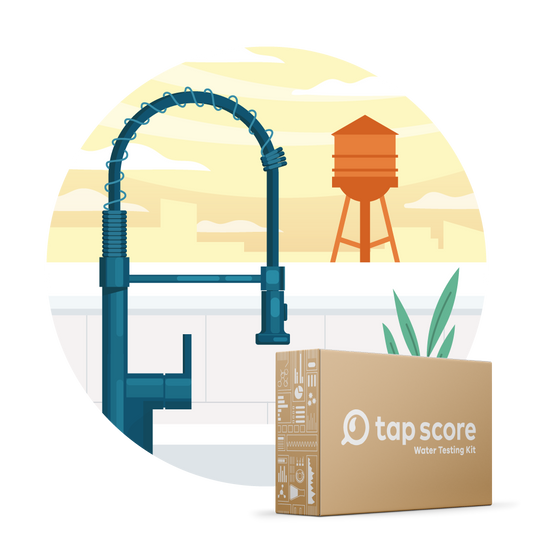
The Ultimate Guide to Well Ownership & Maintenance
Our blog is written by real experts— not AI. Each guide is carefully reviewed and updated based on the latest research. Plus, with no affiliate links, you can count on unbiased insights you can trust.
If you want to make sure your private well water is safe to drink, proper well maintenance is indispensable. A little upkeep each year can go a long way to ensure your well remains a reliable and safe drinking water source for decades.
In this ultimate guide to well maintenance, we’ll go over the essentials to keep your water well system functioning properly.
Table of Contents:
- Well Owner’s Maintenance Checklist
- Proper Well Inspection
- Proper Construction and Installation
- Protecting Your Well
- Performance Monitoring
- Testing
- Treatment
- Retiring Unused Wells
- Bonus: Annual Well Maintenance Calendar
Key Takeaways
- A private well is a clean and reliable source of drinking water if it is properly installed, maintained, and tested on a regular basis.
- Installation: Make sure your well has a secure sanitary cap, is fully sealed between the casing and the borehole, and isn’t in a spot where runoff can pool around it.
- Protection: Don’t use anything you wouldn't want to end up in your drinking water within 100 feet of your well.
- Monitoring: Changes in your water quality—like taste, smell, or color—and well yield are signs you need an inspection.
- Inspection & Testing: Even if everything is flowing smoothly, schedule a well inspection at least once a year and test your well water annually for coliform and nitrates.
- Treatment: Use water testing to isolate the best treatment options for your well.
- Regular Maintenance: Keeping an eye on your well and performing general upkeep is an all-year endeavor.
Maintaining Your Well Throughout the Year
The proper care and upkeep of your well is not unlike the care and upkeep of your vehicle. What you regularly put in helps determine the quality of what comes out.
- A diligent well owner should regularly survey their well with their own eyes and hands. This is similar to occasionally scanning your vehicle and making sure your tire pressures are correct, you haven’t spotted any leaks or loosening parts, and your fluids are in good shape.
- Annually, you’ll want to have a well professional perform a well inspection. Each inspector follows a well inspection checklist to guide and standardize their practice. This is similar to taking your vehicle in for routine service where the chief mechanic will perform a standardized multi-point inspection.
Like your vehicle’s owner’s manual, there are a number of recommended practices that you’ll want to follow throughout the year to be sure you’re prolonging the life of your well. We like to call this your well maintenance checklist. The well maintenance checklist includes everything from the basics of regularly surveying your well and protecting your well, to recommending certified well inspection and testing annually.
Homeowner’s Well Maintenance Checklist
The following checklist is a useful summary of all aspects of well upkeep throughout the year, including best practices, regular visual evaluations, annual professional inspections, and your well water testing routine:
- Use licensed or certified well drillers and pump installers when a well is constructed, a pump is installed, or the system is serviced.
- Regularly survey your well. Keep an eye on your well head, proper separation along your property and be aware of changes in your well and the area around it.
- Have a professional perform an annual well inspection, including a bacterial test.
- Drinking water should be tested annually by a laboratory, and any time there is a change in taste, odor or appearance, or when the well system is serviced.
- Protect your well. Keep hazardous chemicals, such as paint, fertilizer, pesticides, and engine lubricants far away from your well. Prevent back-siphonage: When mixing pesticides, fertilizers, or other chemicals, never put the garden hose inside the tank or container.
- Use caution around your well. A damaged casing negatively impacts your water quality. Don’t mow, pile snow, leaves, or other materials around your well.
- Keep your well records in a safe place. These include the well log, as well as any well system maintenance and water testing results.
- Have a qualified water well contractor decommission your well when it has come to the end of its serviceable life (usually ~20+ years).
We’ll be detailing many of these entries below. At the bottom of this post, you’ll find an annual well maintenance calendar you can consult to help guide your seasonal well work.
Ultimate Guide to Well Water Contaminants
How to Inspect Your Well
As we mentioned, inspecting your well can refer to two equally important actions:
- Regularly surveying your own well, like when performing seasonal maintenance, which is one of your responsibilities as a well owner.
- Having a licensed or certified well professional perform a formal inspection of your well.
How Often Should I Survey My Well?
You should survey your well seasonally—and at convenient points throughout the year. This helps prevent issues that might be setting your well up for more serious problems down the line
- Check your well head and well cap regularly to ensure it is in good condition.
- Be sure proper separations are maintained between your well and other buildings, waste systems, or chemical storage facilities on the property.
- Keep the top of your well at least one foot above the ground. Slope the ground away from your well for proper drainage, and maintain that clearance throughout the year by preventing leaves or snow from building up near your well.
- Be aware of any changes to or in your well, the area around it, or the water it provides.
How Often Should A Well Be Professionally Inspected?
You should have your well professionally inspected once a year—just like testing. Be sure pumps, pipes, and storage tanks are inspected as well. We recommend having your well tested and inspected at the same time each year if there haven’t been any unforeseen circumstances.
Over longer periods of time, cracks and other forms of corrosion can occur that compromise the integrity of your well and the quality of your home’s drinking water. That’s why it’s so important to pair well testing with professional inspection.
Your annual well inspection should include:
- Visual inspection
- Valve inspection
- Electrical testing
- Flow test
- Recommended water tests
Additionally, If you’re looking to buy property with a well, you should also have the well professionally inspected prior to purchase.
Well Inspection Checklist
The Water Systems Council has made the following well inspection checklist available for your convenience. It shows the procedure a licensed inspector will follow.
Entries include the well’s location and condition, component details, and performing a flow test.
Note: If the well falls short of ideal conditions, the inspector should recommend that the homeowner contact a licensed well contractor about a more rigorous evaluation, further water testing and/or the need for well repair or replacement.
Signs You Should Have Your Well Inspected
 Always have your well inspected and/or tested when there are noticeable changes in taste, odor, or color, or pronounced changes in water pressure. Other signs include:
Always have your well inspected and/or tested when there are noticeable changes in taste, odor, or color, or pronounced changes in water pressure. Other signs include:
- Unusually high electricity bill
- Sputtering faucets
- Strange sounds from pipes or pump
- Damaged well cap
If you observe any issues, and/or if you’ve never had a professional inspect your well, contact a licensed professional well inspector immediately.
Is A Well Log Important?
Your well log is a document containing key information on the construction of the well and its geological and topographical profiles. It’s very important to keep one on hand as it will give you a clearer picture of how your well was built. Be sure to ask for all your well records when buying a home or property with a well.
Contractors must file well logs with their respective states upon completion of new wells, though specific well log requirements may differ from state to state.
Always use a licensed or certified contractor when a well is constructed, inspected, or serviced. Want to know where to find a well inspector? Find a well water service contractor near you.
How to Check Your Well for Proper Construction and Installation
If you’re moving onto a property with a well, you’ll want to look into to be sure you’re acquiring a properly constructed well. Poor well construction can lead to issues, like sediment and contamination, that can affect the well’s yield and safety.
 Investing in a professional pre-purchase inspection of a well is highly recommended. But here are some components and features you can check on your own to make sure the well was built correctly:
Investing in a professional pre-purchase inspection of a well is highly recommended. But here are some components and features you can check on your own to make sure the well was built correctly:
- Well casing: The top of your well casing should be at least one foot above ground. This keeps unwanted pests and surface water from getting into your well. The space between the outside of the well casing and the borehole wall (or annular space) should also be fully sealed with grout.[1]
- Well cap: A sanitary well cap is your first line of defense against surface contamination.[2] Regularly check the condition of the cap, making sure that it is securely attached and able to keep out insects and rodents.
- Location: Also be sure your well isn’t located in an area prone to surface runoff (e.g., a low-lying field next to agriculture or a busy road).
- Elevation: The ground surrounding your well should slope away from the well in order to prevent water pooling.
Additionally, make sure your well is properly distanced from key points on your property such as:
- Electric lines and gas pipes
- Animal kennels or confinement areas
- Septic or holding tanks
- Unused wells
How to Protect Your Well Water
Avoid using any chemicals or any other possible sources of contamination within a 100 feet radius of your well. Consider this your well’s protection zone.[4]

Avoid using anything inside of that zone you wouldn't want ending up in your drinking water. This includes substances like:
- Fertilizers
- Pesticides (i.e., insecticides, herbicides, fungicides)
- Motor oils, fuels, lubricants
- Paints
Extend the protection zone if there is any slope above your well that might promote run off from a wider area.
Top Tips for Protecting Your Well:
- Keep the top of your well at least 1 foot above ground
- Keep the well clear of debris
- Protect your well from being hit by vehicles or machinery
- Be sure to take precautions before and after extreme weather events
- Avoid allowing surface water to collect or pool around or near your well
- Never dispose of waste in unused wells
- Never tie an animal to your well
Gardening and Landscaping
Keep short-rooted plants at least 4 feet away from your well, and larger plants at least 20 to 30 feet away.
When landscaping near your well, take care when performing activities that could damage your casing, like using a lawn mower. Roots from plants and trees can also potentially damage your well casing.
Can a Neighbor's Lawn Fertilizer Contaminate My Well Water?
Possibly. Chemicals found in lawn fertilizers, such as nitrate, can leach through the soil into groundwater, especially if your well is shallow or located close to your neighbor’s property. Since these chemicals do not always easily degrade in groundwater, they can accumulate over time, increasing the risk of contamination in the long term.
Wells and Septic Systems
Wells should be installed a minimum of 50 feet away from your septic tank and at least 100 feet from the septic system’s drainfield, although these suggested distances can vary among states.[5] Proper upkeep of your septic system and the quality of your well water is often interrelated.
Pump your septic system at least every 3-5 years to avoid unprocessed water flowing into the drainfield and potentially reaching your groundwater, and have your septic system inspected annually.[6]
New home additions, like waste or chemical storage, should be built in accordance with your well’s protective zone requirements.
How Do I Know if My Well Is Performing Normally?
Your well is performing normally when your water flow is consistent, there hasn’t been any irregular behavior anywhere along the line, and no noticeable changes to color, odor, or taste.
Proper maintenance helps sustain flow, or the amount of water you are able to pump from a well (also referred to as well yield or performance).
Well yield tends to decrease over time, especially if the well was not initially installed properly. While decreases in flow are sometimes caused by persistent droughts, more often decreases in well yield over time are related to changes in the well’s water quality.
This can include:
- Build up from mineral deposits and microorganisms (like iron bacteria)
- Sediment obstructing the well’s pump from the water source
- Damage from pumping sand and sediment
- Corrosion in the well screen or casing
Various contaminants, both microbial and chemical, can cause these changes. Regular well water testing and well inspection can help you identify and successfully treat the culprit.
How Often Should You Test Your Well Water?
Even if your well has been properly built, installed, and has passed all inspections, you should test your well water annually to ensure your water is safe to drink. Well water quality is susceptible to changes in the environment.
Additionally, you should test your water any time there is a noticeable or sustained change in taste, odor, or appearance, or after your well system is serviced.
Is Well Water Safe to Drink?
Unlike city water, your well water safety is in your hands. It’s helpful to learn to identify different symptoms of contamination. However, it’s important to note that many pollutants don’t have easily detectable signs, so proper maintenance and regular water testing is the only way to monitor water quality over time.
Groundwater is susceptible to a range of hazards—from microbes like coliform bacteria and organic contaminants like pesticides to inorganic contaminants like heavy metals and even radiological pollutants like uranium.
Ultimate Guide to Well Water Contaminants
Acidic Well Water
The results of a well water test might reveal that you have acidic well water. Acidic well water is a relatively common issue. It can cause corrosion and a bitter, metallic taste while basic water can have a slippery feel, a baking soda-like taste and can leave white deposits on your fixtures and appliances.

Acidic water by itself doesn’t cause any health problems. However, the corrosion of your plumbing may release toxic heavy metals, like lead and copper, that have harmful effects.
What to Do About Acidic Well Water.
What Should You Test for in Your Well Water?
For routine monitoring, different contaminants should be tested at different frequencies. It’s also very helpful to get to know concerns that are specific to your region, like if you live near heavy industry or agriculture, or if your aquifer has naturally occurring geogenic contaminants like arsenic or uranium.
The list below is provisional and based primarily on the most common problems for wells nationwide. However, groundwater is very context specific! It's important to take this list as a starting point, and do the required research on your local area to know what's most important to test.

It’s also a good practice to test your well water whenever there are major land use changes visible from your property, like gas drilling, agriculture, or industrial activity.
Get in touch with your local health or environmental health department to discuss any contaminants of particular concern in your area.
How Do I Test My Well Water in a Lab?
When Should I Test a Newly Drilled Well?
Newly drilled wells will need to be run at least 24 hours before testing. This allows the well to "settle in" so that the water being tested is more indicative of the water you will be using.
Sampling your well right after installation won't accurately represent water quality as it will likely have increased sediment and potentially other contaminant spikes. Nevertheless, we recommend you test your well before commencing full use. Just allow for the settling period first.
Where Can I Get My Well Water Tested for Free?
Reaching out to your state water board or other agency is your best bet to try and test your well water for free. Avoid free tests from filtration companies as they’re usually a part of an aggressive sales campaign.
The Best Well Water Test Kit
Always test before you treat. To test your water confidently and accurately you want to use a certified laboratory. “Free” tests and DIY kits have major drawbacks compared to a professional lab, like reduced accuracy or high detection limits.
Testing your water with a lab is easy, especially with Tap Score’s Well Water Core Kits.
Check your state’s well maintenance requirements to see if additional routine testing is needed.
Well Water Treatment Options
After you test your well water, you might find that you have contaminants you’d like to remove. Most water quality problems can be successfully resolved with the right treatment. But you need to know exactly what you’re looking to treat in order to make the best decision.

- Point-of-entry (POE) devices and disinfection techniques allow you to treat your well water before it enters your home.
- Point-of-use (POU) devices treat your water at the tap where it will be used.











